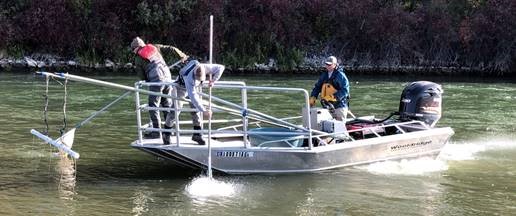
The Idaho Department of Fish and Game continued annual fish population monitoring at the Conant and Lorenzo monitoring reaches of the South Fork Snake River in the fall of 2021 to evaluate the effectiveness of management actions on the river, and health of trout populations. Data from these surveys are used in decision making to achieve the goals outlined in the state fish management plan, which include preserving the genetic integrity and population viability of native Yellowstone cutthroat trout (YCT) and reducing rainbow trout (RBT) abundance to less than 10% of the species composition at the Conant monitoring reach in the upper river. This is an initial summary of the 2021 survey results from these reaches and may be subject to change with further review and analyses. Estimates below are for age-1 (approximately 4-inch) trout and older.
Conant Reach

In 2021, the total trout abundance at Conant decreased from 6,175 trout/mile to 4,617 trout/mile, which is slightly lower than the 10-yr. average of 5,170 trout/mile.
The Yellowstone cutthroat estimate for 2021 was 1,869 YCT/mile and was lower than the 2020 estimate of 2,731 YCT/mile, but similar to the 10-yr. average of 1,855 YCT/mile. Yellowstone cutthroat comprised 43.1% of the total trout catch during the survey, which was an increase from 2020 (33.6%).
The rainbow trout estimate came in at 2,063 RBT/mile and was not significantly different from the 2020 estimate of 2,230 RBT/mile and was above the 10-yr. average of 1,888 RBT/mile. Rainbow trout comprised 33.2% of the total trout catch during the survey, which decreased from 2020 (43.1%).
The brown trout (BNT) estimate of 1,073 BNT/mile was not significantly different from the 2020 estimate of 1,342 BNT/mile but was slightly below the 10-yr. average of 1,136 BNT/mile (see Figure 1). Brown trout comprised 23.7% of the total trout catch during the survey, which was similar to 2020 (22.4%).
Fisheries biologists continue to observe high abundances of total trout and a very stable brown trout population. Rainbow trout suppression efforts have not resulted in significant declines to rainbow trout abundance yet, but it is still early in this long-term management effort. Notable changes to the species compositions of rainbow trout and Yellowstone cutthroat trout provide encouragement that additional suppression efforts may help to achieve the management goals for reducing rainbow trout abundance.
Lorenzo Reach

In 2021, the combined abundance of Yellowstone cutthroat and brown trout in the Lorenzo reach is estimated at 2,359 trout/mile. Not significantly different from 2020's estimate of 2,650 trout/mile, but above the 10-yr. average of 2,011 trout/mile.
The Yellowstone cutthroat estimate of 903 YCT/mile was not significantly different from 2020 estimate of 1,260 YCT/mile, but was much higher than the 10-yr. average of 496 YCT/mile. Yellowstone cutthroat comprised 35.4% of the total trout catch during the survey.
The brown trout estimate of 1,456 BNT/mile was not significantly different from the 2020 estimate of 1,390 BNT/mile and is very close to the 10-yr. average of 1,511 BNT/mile (see Figure 2). Brown trout comprised 56.8% of the total trout catch during the survey.
Catch for rainbow trout was too low to generate a mark-recapture estimate, so it is not directly comparable to the other estimates of species composition listed here. However, using species composition and total trout abundance biologists roughly estimate 224 RBT/mile in 2021, which was higher than the 10-yr. average of 63 RBT/mile. A total of 89 rainbow trout were caught during this sampling which comprised 7.8% of the total trout catch.
Yellowstone cutthroat trout and brown trout populations remain stable with continued high abundances. The rainbow trout population is something fisheries managers will continue to watch due to their increasing abundance and catch composition over two consecutive years.
Lufkin Bottom Reach

The Lufkin Bottom reach has been surveyed intermittently since 2014 to monitor shifts in species compositions in this section of river. This is the fifth year biologists have sampled this reach to describe species composition and abundance of trout within the Canyon of the South Fork Snake River. In the future, they plan to survey this section every three years.
In 2021, the total trout abundance at Lufkin is estimated at 4,670 trout/mile and was not significantly different from 2018 estimate of 4,314 trout/mile, which is higher than the average 3,664 trout/mile.
The Yellowstone cutthroat trout estimate was 1,524 YCT/mile. Not significantly different from the 2018 estimate of 1,713 YCT/mile but lower than the average 1,708 YCT/mile. Yellowstone cutthroat comprised 34.0% of the total trout catch during the survey, which decreased from 2018 (38.7%).
The brown trout estimate of 2,736 BNT/mile was not significantly different from the 2018 estimate of 1,386 BNT/mile and was higher than the average 1,128 BNT/mile (see Figure 3). High brown trout catch but few marked recaptures resulted in low accuracy of this estimate. Brown Trout comprised 35.7% of the total trout catch during the survey, which was similar to 2018 (34.2%).
The rainbow trout estimate came in at 1,079 RBT/mile and was not significantly different from 2018 estimate of 1,386 RBT/mile. It was above the average 924 RBT/mile. Rainbow trout comprised 30.3% of the total trout catch during the survey, which increased from 2018 (27.1%).
The Lufkin Bottom reach appears to have consistently high abundances of total trout and the brown trout population is stable. The proportion of rainbow trout has increased slightly and the proportion of Yellowstone cutthroat trout has slightly decreased. This change in species composition is a concern, though the changes appear to be minimal so far.

